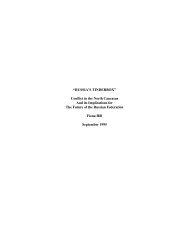The Heart of the Matter Valerie M. Hudson, - MIT Press Journals
The Heart of the Matter Valerie M. Hudson, - MIT Press Journals
The Heart of the Matter Valerie M. Hudson, - MIT Press Journals
Create successful ePaper yourself
Turn your PDF publications into a flip-book with our unique Google optimized e-Paper software.
<strong>The</strong> <strong>Heart</strong> <strong>of</strong> <strong>the</strong> <strong>Matter</strong> 23<br />
True to evolutionary <strong>the</strong>ory, individuals repeat responses that are functional<br />
and drop those that are nonfunctional: for example, Thayer notes, “Culture allows<br />
warfare to be ei<strong>the</strong>r suppressed or exacerbated. ...Itisdifªcult to overstate<br />
<strong>the</strong> signiªcance <strong>of</strong> educational systems, popular culture, and <strong>the</strong> media,<br />
among many [proximate] causal mechanisms.” 51 It is <strong>the</strong> environment that determines<br />
<strong>the</strong> nature <strong>of</strong> <strong>the</strong> ªttest response. 52 Here we glimpse <strong>the</strong> proximate<br />
causes <strong>of</strong> cultural selection in <strong>the</strong> very act.<br />
Indeed, ªndings in psychology demonstrate that very young boys do not<br />
display more violence toward girls than girls display toward boys. Although<br />
many studies have concluded that among pre-school-age children, boys are<br />
more physically aggressive than girls, 53 when <strong>the</strong> stimulus <strong>of</strong> gender is<br />
removed, 54 <strong>the</strong>re is no difference between <strong>the</strong> amount <strong>of</strong> aggression boys display<br />
against girls and girls display against boys. 55 Ra<strong>the</strong>r, three factors are<br />
likely to play prominent roles in training individuals to become more violent<br />
against women: modeling, immediate reinforcement, and male-bonded<br />
groups.<br />
modeling. <strong>The</strong> ªrst adults whom children observe regularly interacting are<br />
<strong>the</strong>ir parents. In homes where interparental violence occurs, children who witness<br />
such violence are susceptible to adopting <strong>the</strong> aggressive behavior patterns<br />
<strong>the</strong>y observe. 56 Such child witnesses <strong>of</strong> violence between <strong>the</strong>ir parents<br />
are more likely to be violent with <strong>the</strong>ir peers and with <strong>the</strong>ir partners in future<br />
relationships. Those children found to be most violent are sons <strong>of</strong> abusers fol-<br />
51. Thayer, Darwin and International Relations, pp. 151–152.<br />
52. Patterson, “A Comparison <strong>of</strong> Models for Interstate War and Individual Violence.”<br />
53. Raymond H. Baillargeon, Mark Zoccolillo, Kate Keenan, Sylvana Côté, Daniel Pérusse, Hong-<br />
Xing Wu, Michel Boivin, and Richard E. Tremblay, “Gender Differences in Physical Aggression: A<br />
Prospective Population-Based Survey <strong>of</strong> Children before and after Two Years <strong>of</strong> Age,” Developmental<br />
Psychology, Vol. 43, No. 1 (January 2007), pp. 13–26; and Jamie M. Ostrov and Caroline F.<br />
Keating, “Gender Differences in Preschool Aggression during Free Play and Structured Interaction:<br />
An Observational Study,” Social Development, Vol. 13, No. 2 (April 2004), pp. 255–277.<br />
54. Janet S. Hyde, “New Direction in <strong>the</strong> Study <strong>of</strong> Gender Similarities and Differences,” Current<br />
Directions in Psychological Science, Vol. 16, No. 5 (October 2007), pp. 259–263.<br />
55. Bonnie Ballif-Spanvill, Claudia Clayton, Rebecca Nichols, and Rachel Kramer, “Dyad Differences<br />
in <strong>the</strong> Violent and Prosocial Behavior <strong>of</strong> Same- and Mixed-Set Pairs <strong>of</strong> Three-Year-Olds,”<br />
manuscript in preparation.<br />
56. E. Mark Cummings, Marcie C. Goeke-Morey, and Lauren M. Papp, “Everyday Marital Conºict<br />
and Child Aggression,” Journal <strong>of</strong> Abnormal Child Psychology, Vol. 32 No. 2 (April 2004), pp. 191–<br />
202; Jeffrey L. Edleson, “Children’s Witnessing <strong>of</strong> Adult Domestic Violence,” Journal <strong>of</strong> Interpersonal<br />
Violence, Vol. 14, No. 8 (August 1999), pp. 839–870; Sandra A. Graham-Bermann, “<strong>The</strong> Impact<br />
<strong>of</strong> Woman Abuse on Children’s Social Development: Research and <strong>The</strong>oretical Perspectives,” in<br />
George W. Holden, Robert Geffner, and Ernest N. Jouriles, eds., Children Exposed to Marital Violence:<br />
<strong>The</strong>ory, Research, and Applied Issues (Washington, D.C.: American Psychological Association, 1998),<br />
pp. 21–54; and Gayla Margolin and Elana B. Gordis, “<strong>The</strong> Effects <strong>of</strong> Family and Community Violence<br />
on Children,” Annual Review <strong>of</strong> Psychology, Vol. 51 (February 2000), pp. 445–479.
















